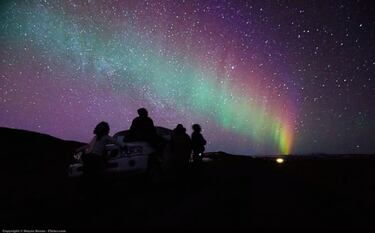Northern Lights: what time are they visible, forecast tonight and where to look for the Aurora Borealis
As the Sun awakens there may be a good chance of seeing the Aurora Borealis further south than normal. Check out where you can see the otherworldly sight.

Depending on where you live you might have the opportunity to see the celestial light show known as the Aurora Borealis or the Northern Lights. Normally only seen closer to the poles, a recent strong solar flare could make viewing possible at lower latitudes.
The effects of the solar storm, also known as a geomagnetic storm is expected to last for a few days but as the Sun wakes up from an unusually long slumber more events could be on the horizon, literally for some viewers.
What causes the Aurora Borealis?
The Northern Lights are produced when highly charged particles from the Sun get funneled by the Earth’s magnetic field and they fall into the atmosphere at high speed. Then those particles interact with the upper atmosphere, at altitudes of 60 to more than 250 miles up, and the resulting ionization of the atmosphere creates the colorful dance of light across the sky. They can glow in a variety of colors, including vivid greens and purples.
The Northern Lights are most commonly seen in the polar regions with the best viewing anywhere with a magnetic latitude above 55º and low light pollution. You can find your magnetic latitude either at NOAA or World Data Center for Geomagnetism.
However with strong solar flares the lights can be seen at lower latitudes than normal. For a reference Minneapolis is at 55º magnetic latitude and about 300 miles from the Canadian border but Seattle less than half the distance is at less than 53º. This latest storm was a Level 3 (out of 5) event which makes it a strong solar wind and the Aurora Borealis may be visible as far south as Oregon and Iowa.

How can I see them?
The Northern Lights can occur anytime of the year but the darker it is the better. The best time to view the Aurora Borealis is during the equinoxes in March and September. They don’t usually exhibit for long coming and going a few minutes at a time. A good display may last for no longer than 15-30 minutes at a time, although if you’re really lucky, it could extend to a couple of hours or longer.
Related stories
To see them the sky needs to be dark and clear of any clouds. They may appear like illuminated rain on the horizon depending on your latitude but the further north, or south depending on the hemisphere, you go the better chance they will fill the sky. National Geographic gives 7 of the best locations to view them.
How can I know when the Northern Light will appear?
There is no 100% guarantee of spotting the Northern Lights just hope that you are in the right place at the right time. There are forecasts available with the Kp Index is generally considered the most accurate. The forecast corresponds to the planetary magnetic index on a scale of one to nine, with one being very low activity and nine very high. The Geophysical Institute at the University of Alaska has an excellent website, which allows you to view predicted activity in all auroral regions. You can also sign up for Northern Lights forecast email alerts that tell you when activity rises above four to five on the Kp scale.


